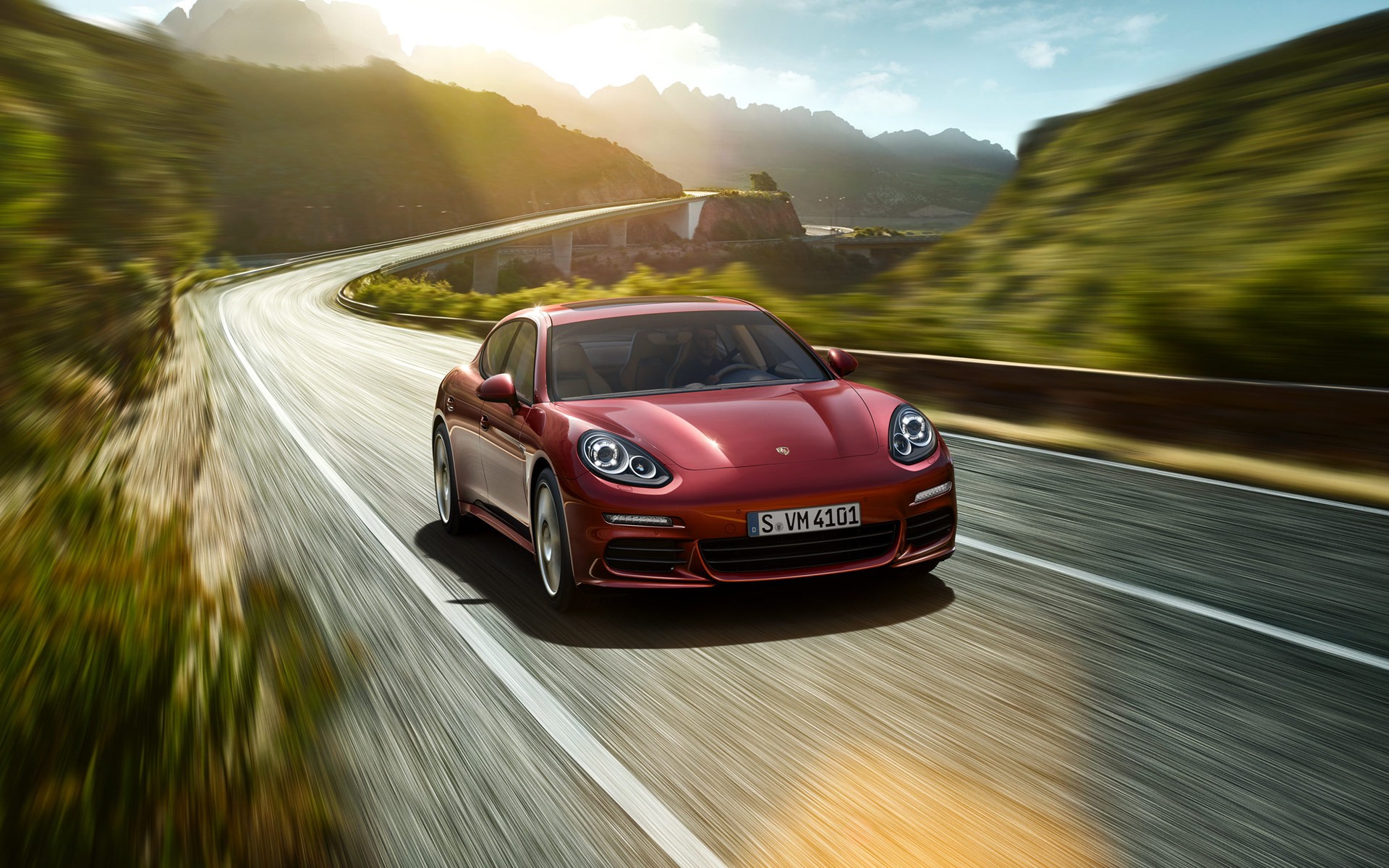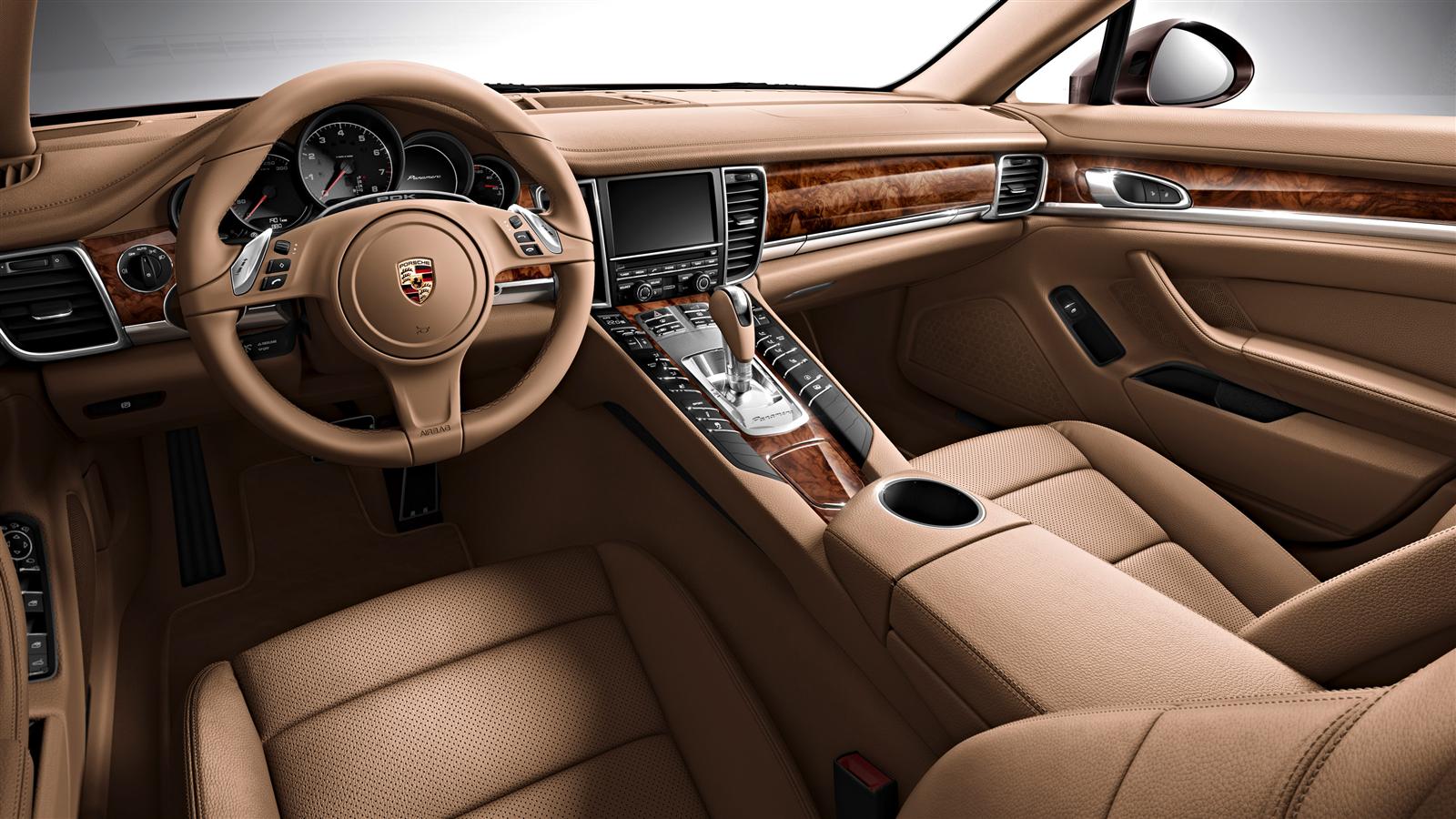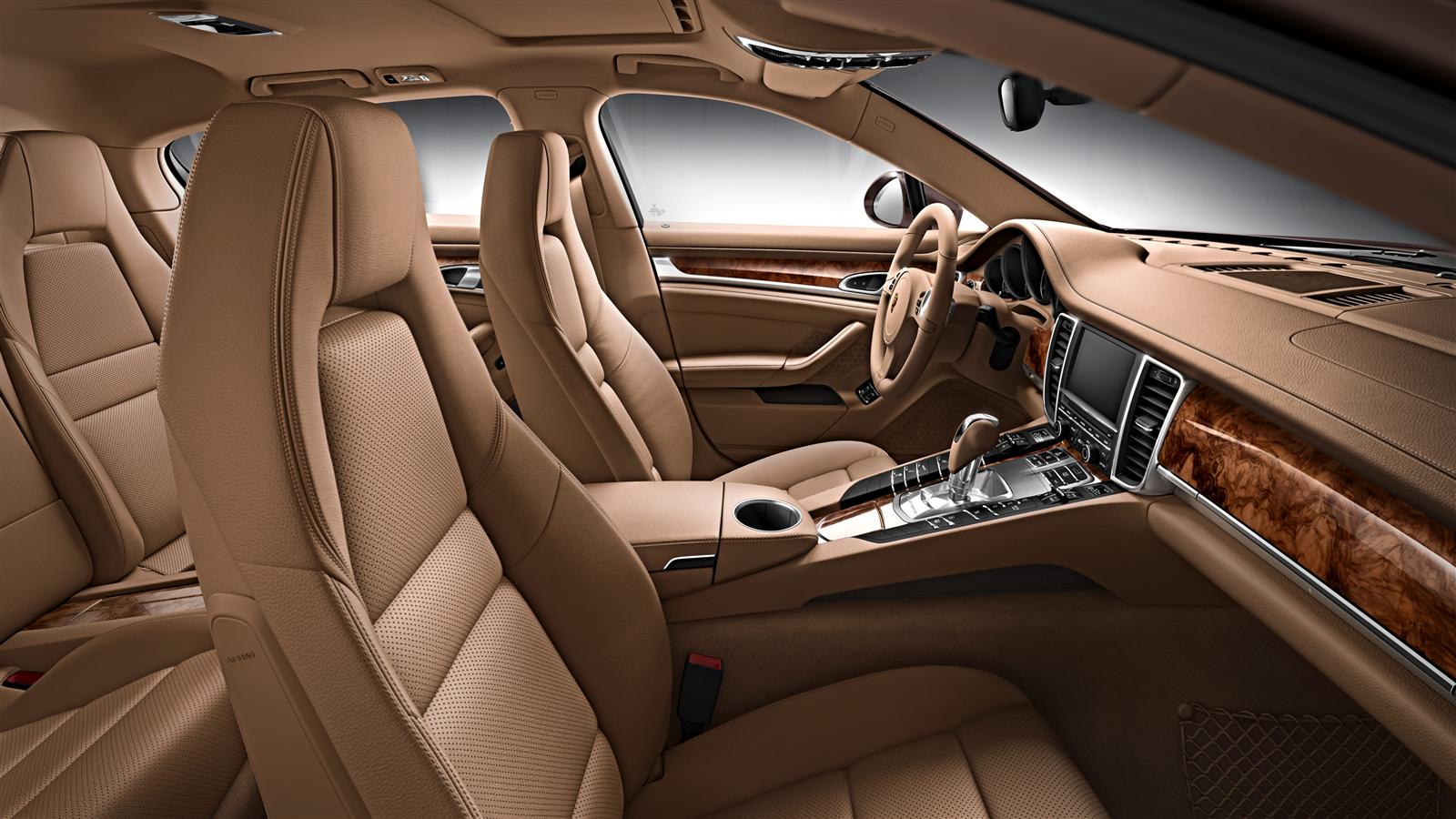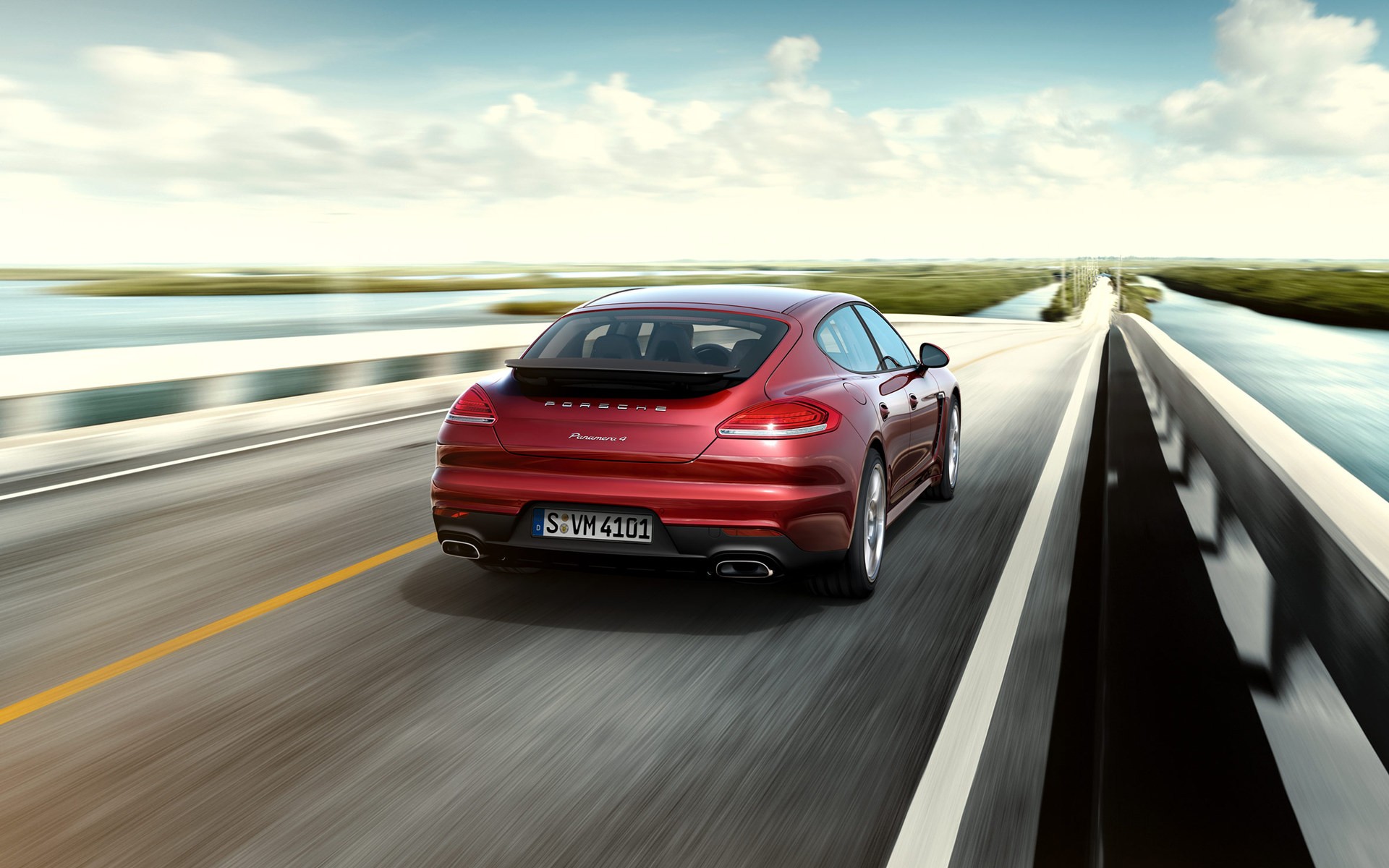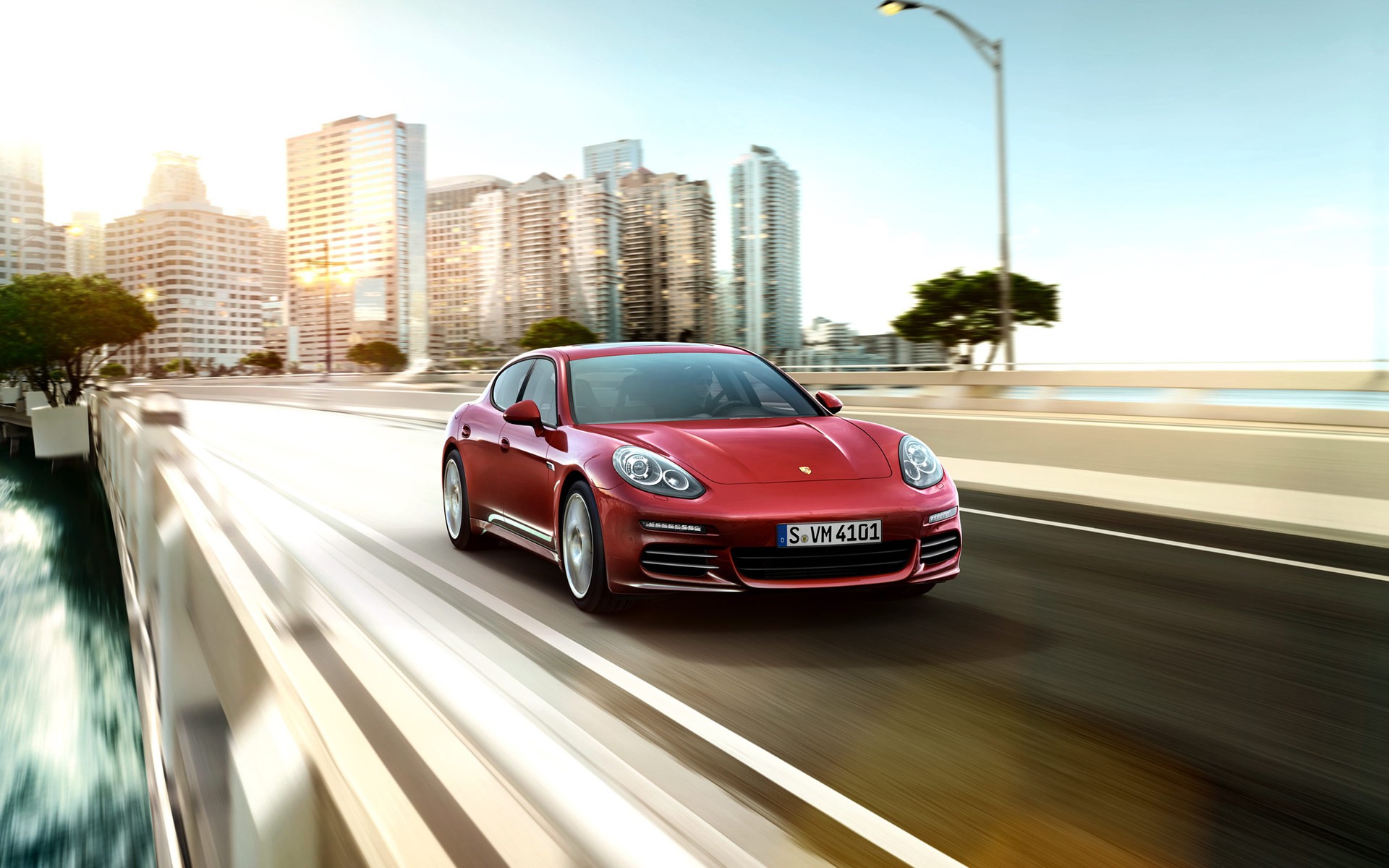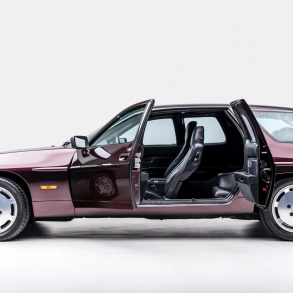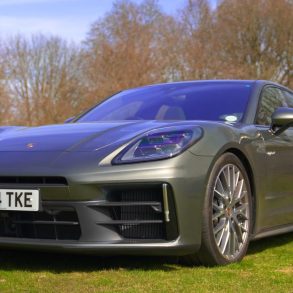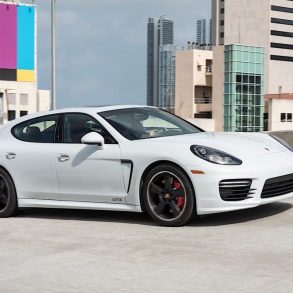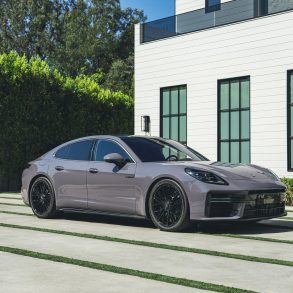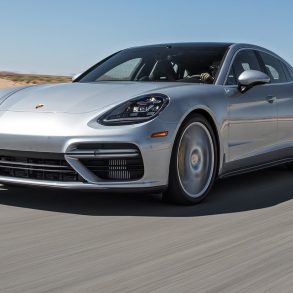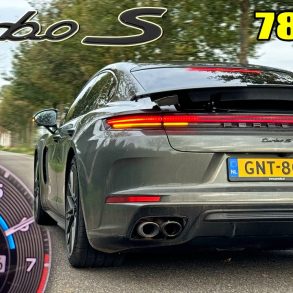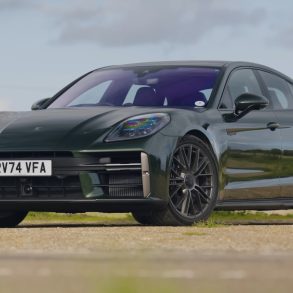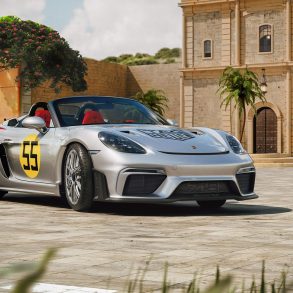(2014 – 2016) Porsche Panamera 4 – The Ultimate Guide
The Panamera received a fairly substantial mid-cycle update for 2014. The base engine, installed in the Panamera 4 version, was an upgraded version of the previously used 3.6-liter V6. For the 2014 model year, it was mated exclusively with a 7-speed (PDK – dual-clutch) automatic gearbox and the 6-speed manual was dropped. It also gained some extra horses. The power of the V6 engine in the Panamera and Panamera 4, for example, increased ten hp (eight kW) to 306 bhp @ 6200 rpm and 295 ft lbs @ 3750 rpm of torque, while the fuel consumption decreased 0.9 litres to significantly less than nine litres per 100 km.
A major improvement for the Panamera 4 was the standard bi-xenon headlights and the option for full LED lamps. The daytime running lights were fitted with light-emitting diodes as standard. The revised front and rear bumpers brought a more aggressive look for the car. The bigger side-scoops in the apron were inspired by those installed on the 911 range. A wider rear windscreen was installed on the new tailgate. Despite the high price-tag, the rear wiper was offered as an option.
Inside, the manufacturer installed the PCM (Porsche Communication Management) for the infotainment system. It supported Apple CarPlay connectivity, but its compatibility with Android phones was limited. The tachometer was mounted in the middle of the instrument cluster, with a round TFT display on its right side, where the navigation system could have been shown, as well as other on-board computer information. A bi-color leather interior was offered as an option.
Pictures
Press Release
Porsche celebrated the world premiere of the new Porsche Panamera at the 2013 Shanghai Motor Show. The most spectacular new product is the Panamera S E-Hybrid, the world’s first plug-in hybrid in its class. The Porsche Panamera range now consists of ten models, including the two new luxurious Executive versions with an extended wheelbase. Also making its debut is the entirely new three-litre V6 engine with biturbo charging for the Panamera S and Panamera 4S. So, Porsche is extending its Gran Turismo model series – which was already unrivalled in its broad base of models. The new series offers even greater performance, efficiency, comfort and convenience. The advanced styling of the Panamera takes on the design language of Porsche sports cars that features highly precise lines and newly shaped body elements.
For Porsche, China is the second largest single market after the USA – and larger than its domestic market Germany. In 2012, the sports car producer delivered 31,205 vehicles to Chinese customers – a 28.2 per cent gain compared to 2011. China is the world’s largest global market for the sporty Cayenne SUV and the Panamera sport sedan.
To meet the sustained demand of Chinese customers, Porsche is extending its dealer network. A new Porsche Centre is opened in China nearly every month. In sum, the company plans to extend its existing dealer network from over 50 Porsche Centres today to around 100 locations. Porsche is also building Asia’s first Porsche Driving Experience Centre next to the Shanghai International Circuit motorsport race course. The 100,000 square meter site with its test track, slalom courses, off-road parcours and training classrooms is exclusively reserved for Porsche customers and fans. When it is completed in 2014, the Porsche Driving Experience Centre in Shanghai will be the third customer test centre in the world along with Leipzig and Silverstone in England.
Forward-looking: World’s first plug-in hybrid drive in the luxury class
Now in its second generation, Porsche is introducing the world’s first plug-in hybrid to the luxury class. In addition to the Panamera S E-Hybrid, which offers 416 hp of system power, two luxurious Executive versions are also making their debut with an extended wheelbase and an entirely new three-litre V6 engine for the Panamera S and Panamera 4S that fea tures biturbo charging. New advanced technologies have enabled fuel savings of up to 56 per cent, while further enhancing operating and driving comfort. The new Panamera under scores its exceptional positioning with the even more expressive design language of the new sports car generations that are marked by tighter lines, more pronounced contours and newly shaped body elements. In short: The Porsche Panamera is even more efficient, sporty, com fortable and elegant.
Panamera S E-Hybrid sets new standards in efficiency, performance and operating convenience
This car is a systematically advanced development of the parallel full hybrid with a more powerful electric motor, a higher-performance battery that supplies more energy and the ability to charge it externally from the electrical grid. The electric drive produces 95 hp (70 kW), which is more than double the power of the previous model’s electric motor at 47 hp (34 kW). It draws its energy from a newly developed lithium-ion battery, which at 9.4 kWh has over five times the 1.7 kWh energy capacity of the previous battery in nickel metal hydride technology. When connected to an industrial outlet, it can be charged within around two and a half hours via the integrated on-board charger and the standard Porsche Universal Charger (AC), and it can be charged in less than four hours when plugged into a household electrical outlet in Germany.
The Porsche Panamera S E-Hybrid far exceeds the driving performance of the previous model. In addition, the previous model’s NEDC fuel consumption of 7.1 l/100 km was reduced by 56 per cent to 3.1 l/100 km. At the same time, its all-electric driving performance was substantially improved with regard to electric acceleration, the electric range and electric top speed. An intensive pure electric driving experience is possible without any fuel consumption or local emissions, which is especially advantageous in the urban environment. The Panamera with the new hybrid drive can reach speeds of up to 135 km/h in electric mode.
The performance of the Panamera S E-Hybrid is typical of a Porsche. The internal combustion engine and electric motor are mechanically joined to the rear final drive, as on the previous model, to ensure spontaneous accelerations and impressive continuous power on country roads or motorways. Acceleration time from a standstill to 100 km/h was shortened by half a second to 5.5 seconds. The electric boost function helps here, in which the performance of the electric motor boosts that of the combustion engine. Boosting can also be activated by kick-down – such as in overtaking situations. The car’s top speed is 270 km/h. The parallel full hybrid concept developed by Porsche also offers “coasting” at higher speeds, which refers to free coasting with the internal combustion engine shut off and energy recovery by generating electricity.
Each Panamera S E-Hybrid is supplied with standard and extensive charging equipment. This equipment includes the mobile Porsche Universal Charger (AC) with two power cables for residential and industrial electrical outlets and a charging dock that can be installed in a home garage.
The forward-looking concept of the Panamera S E-Hybrid also embodies an entirely new range of convenience functions, which can also be activated and called up by a smartphone app. There is the charge status indicator, for example. In addition, the auxiliary climate control option of the plug-in hybrid enables car preheating or cooling via Porsche Car Connect; it can be programmed in the vehicle or even more conveniently via the smartphone app. A smartphone may also be used for battery management or to remotely access vehicle information such as remaining driving range or show users the way back to their parked vehicles.
All functions not specifically related to the hybrid drive are also available as options for the other Panamera models via the Car Connect smartphone app from Porsche.
Long wheelbase, spacious rear seating area: Executive models with the comfort of the exclusive class
The spatial concept of the Panamera, with two full-sized bucket seats in the rear seating area, proved to be so successful that Porsche is further extending it in the new generation Gran Turismo. The new Executive models – with their 15 cm longer wheelbase – offer more rear seating space and even better ride comfort. These models offer a very comprehensive package of features; above all they offer exceptional comfort at both rear seat locations as standard. All Executive models have the innovative Panamera air suspension, which combines excellent ride comfort and typical Porsche driving properties.
More performance and efficiency by downsizing: new V6 biturbo engine
Boosting performance and efficiency is a core competency at Porsche. In developing the new Panamera, this competency led to an entirely new engine based on the downsizing concept: a V6 engine with three litres displacement and biturbo charging. The V6 biturbo replaces the previous 4.8-litre V8 engine in the Panamera S and Panamera 4S, and it is also used in the new Executive version of the Panamera 4S. Its basic parameters are themselves indicators of progress: 20 hp more power and 20 Newton metres more torque, but up to 18 per cent better fuel economy compared to the V8 engine in the previous model. So, the driver not only gets a more powerful and efficient engine; turbocharging results in a maximum torque of 520 Newton metres over a very wide range of engine speeds for a superior and uniform performance curve, even at low revs.
Most Panamera models are equipped with the seven-speed Porsche Doppelkupplung PDK. The comfortable eight-speed automatic Tiptronic S is used in the Panamera Diesel and Panamera S E-Hybrid. This transmission creates optimal conditions for the development of other efficiency functions. For example, the extended start-stop function now deactivates the engine earlier, while coasting to a stop, which saves more fuel. With the exception of the Panamera GTS, models with PDK also offer a coasting function in which the clutches open in response to overrun, the engine idles, and the vehicle coasts freely. This function can significantly improve fuel economy, especially in motorway driving.
Further advanced design with a new option: LED headlights
The further advanced exterior design of the Panamera can be made out at first glance. The tighter and more prominent linework at the front end is especially apparent in the larger air intakes and the distinctive transition to the headlights. In side profile, the new, more swept-back windscreen creates an even more extended silhouette. This taut, elegant linework is even more pronounced on the Executive models. The rear doors are 15 centimetres longer, which gives new proportions to the windows of the Panamera.
When viewed from the back, the new generation Panamera is primarily made out by its new boot lid. The widened rear windscreen emphasises horizontal aspects of the Gran Turismo and therefore its sporty character. This effect, which gives the Panamera the visual appearance of a lower stance on the road, is reinforced by integrating the licence plate bracket lower in the bumper. The rear body section itself was also redesigned. It features a wider spoiler and a tighter transition to the rear lights, similar to the visual transition of the headlights at the front of the car.
As in previous models, the new Panamera models also have many differentiating exterior characteristics. Along with the colour contrast of the brake callipers, which is associated with the specific engine, the most significant identifying characteristics are the differently shaped front-end components and model-specific tailpipes. Further customisation is achieved by the many options that are offered, including the new LED headlights, which give the Gran Turismo a very special appearance. The LED headlights are paired with the intelligent Porsche Dynamic Light System Plus (PDLS Plus). The design of these headlights is funda mentally different from the standard bi-xenon version: The running lights are produced directly by two LED units, one placed above the other, while the position lights and turn indicator lights are relocated to the front body.
The Porsche Panamera models are further upgraded by new standard features such as bi-xenon headlights, multifunction steering wheel and an automatic power lift boot lid. In addition, an extended line-up of assistance systems is available for safety and convenience. The optimised adaptive cruise control system, for example, now actively intervenes in the braking process in hazardous situations. Camera-based traffic sign detection and lane departure warning offer greater convenience in cross-country and motorway travel.
Just 3.1 litres of fuel per 100 km and over 400 hp
In the Panamera S E-Hybrid, efficiency and sportiness enter into a combination that is so far without equal. It is the world’s first plug-in hybrid model in its class. The plug-in hybrid’s system power of 416 hp (306 kW) and 5.5 seconds performance in the sprint from a standstill to 100 km/h position it on the same power level as a car powered by a V8 engine. NEDC fuel consumption is just 3.1 litres per 100 km, which equates to 71 g/km CO2 emissions. In addition, the Panamera S E-Hybrid is the first Porsche model to already fulfil the Euro 6 emissions standard, which does not take effect until September 2014.
In the new Panamera S E-Hybrid, the parallel full hybrid drive of the previous model was further engineered, and plug-in technology was added. The car’s external charge port enables charging of the traction battery from the electrical grid. The Panamera S E-Hybrid stores this energy in a newly developed lithium-ion battery, and its more powerful electric motor converts this energy with significantly stronger driving performance and longer driving range than before.
For the driver, the new battery and new electric motor mean significantly better electric driving performance: All-electric acceleration from 0 to 50 km/h takes 6.1 seconds, and the all-electric top speed is an unrivalled 135 km/h. The electric driving range of the Panamera S E-Hybrid was determined to be 36 kilometres in NEDC-based testing. However, driving range in real operation may vary, e.g. because air conditioning and heating are deactivated in NEDC test conditions. A realistic all-electric driving range in everyday operation would therefore lie somewhere between 18 and 36 km – and under especially favourable conditions it could even exceed these values.
In interplay with the V6 engine, the high torque of the electric motor enables low revs for sporty drive-off as well, ideally complementing the internal combustion engine that develops its full torque at higher revs.
The innovative E-Hybrid drive concept of the Panamera S E-Hybrid can already be made out from its exterior. Use of the accent colour Acid Green is restrained, but it clearly highlights the two side “e-hybrid” logos on the front doors, and the “Panamera S” model logo at the rear has a border in Acid Green as well. The brake callipers are also painted in this colour and provide additional differentiation from the conventional S model. The pointers of instruments in the instrument cluster and of the optional Sport Chrono chronometer are designed in Acid Green as well – a sign of the E-Hybrid.
New with more energy and power: lithium-ion battery and electric motor
The newly engineered high-voltage battery based on lithium-ion technology with an energy capacity of 9.4 Kilowatt-hours can store over five times the amount of electric energy as the nickel metal hydride battery in the previous model, and yet it does not require any more installation space. As before, it is integrated in a space-saving way beneath the boot floor. However, the great advantage of lithium-ion technology is not just its high energy density. Its power density is also greater, and this enables a high level of electric performance. The battery is maintenance-free and is not a wear part. Generally, Porsche offers a warranty of six years or 120,000 km. Other warranty periods are possible in other markets.
The Panamera S E-Hybrid exploits the multiplied supply of electric energy in its more advanced electric motor. Its short-term peak power of 95 hp (70 kW) is over double the peak power in the previous Panamera S Hybrid of 47 hp (34 kW). This was primarily attained by increasing the number of windings on the electric motor’s stator coils, which increased voltage from the previous 288 Volt to 360 Volts and adding new power electronics. A modified magnetic material in the rotor’s electromagnetic circuit together with optimised cooling channel geometry also led to an improvement in thermal load capacity. This has all enabled a higher maximum torque of 310 Newton metres (gain of ten Newton metres) which is available from zero to 1,700 rpm. Despite the substantial improvement, the dimensions of the electric motor are no larger, so it can easily be mounted in the existing installation space.
Three driving modes for customised use of the electric drive
The Panamera S E-Hybrid offers special driving modes that give drivers better everyday driving utility. The driver can select them individually to exploit the strengths of the individual hybrid driving states. The E-Power mode enables pure electric driving without having to start the internal combustion engine. Moreover, it is possible to charge the high-voltage battery during the drive by the E-Charge mode. Another driver selection option is the Sport mode which offers typical Porsche engine performance and a sporty accelerator pedal characteristic for more direct response.
Hybrid-specific indicators in the instrument cluster and in the optional Porsche Communication Management (PCM) communicate key information to the driver at all times. The new Power Meter replaces the analogue tachometer and informs the driver of the drive power and electrical system recuperation power of the hybrid system. Digital speedometer values are still continually shown in the display of the central round instrument. The Power Meter also communicates other useful information to the driver such as system readiness when the ignition is switched on (Ready indicator), an efficient or especially sporty driving range (efficiency range or boost range) and the activation point of the internal combustion engine when greater power is demanded.
Intelligent charging strategy reduces costs and increases everyday utility
The Porsche Universal Charger (AC) is a standard feature of the Panamera S E-Hybrid, and it is used to connect the vehicle to the electrical grid. The attractively styled charger from Porsche Design includes two standard power cables, one for household electrical outlets, and the other for plugging into industrial or high current electrical outlets. Depending on the available connection, the customer can readily connect to the charger via the appropriate mains adapter. Depending on the type of power connection, the Panamera S E-Hybrid may be charged in just around two and a half hours (at 16 Amperes) or in less than four hours (at 10 Amperes). Also included as standard equipment is a charging dock in Porsche design that is used to conveniently mount the universal charger (AC). The charging dock can be installed in a residential garage.
On the car’s exterior, the plug-in concept of the Panamera S E-Hybrid can also be made out by the charging door on the left rear side panel; the vehicle’s electrical port for charging the lithium-ion battery is located behind this door. The on-board charger for voltage regulation and converting AC to DC power is installed in a space-saving location in the right side wall of the boot; it outputs up to 3.6 kW. Two LED lights integrated in the charge plug inform the user of the charge state of the lithium-ion battery and the connection status. There is also a departure timer for setting the timing of the charging process. Up to three target times can be programmed via the instrument cluster. Then battery charging is per formed so that the battery is fully charged at the defined time point. One benefit is that less expensive night-time electrical power rates might be used.
Unique comfort: remote control by smartphone and auxiliary climate control With the new Panamera, Porsche is introducing remote control of the vehicle via a smartphone app under the name Porsche Car Connect, which satisfies growing customer needs for connectivity. In the Panamera S E-Hybrid, networking of vehicle and driver via a smartphone plays a special role, because it makes special functions such as external charging of the high-voltage battery more transparent. The driver can access and control key information about the vehicle using a smartphone app. Shown on the phone, along with battery charge status with remaining charge time, are the current driving ranges – for both electric driving and combustion engine driving. The electric driving range is also shown on a navigation map. The “Charge timer” function can be programmed to optimize electricity costs.
In the Porsche Panamera S E-Hybrid, electrification of the climate control system has created the right conditions for another option: auxiliary climate control. The charge timer may be used to activate the climate control system so that the passenger compartment has the preset desired climate at a planned departure time. The vehicle interior is either heated or cooled accordingly. In the winter, heating power is also generated by an auxiliary high-voltage heater.
Gran Turismo with long wheelbase offers maximum comfort
Porsche developed the Executive models for customers who have especially high standards for space, ambience and ride comfort. The wheelbase and passenger compartment were extended by 15 centimetres, and both of these dimensions directly benefit comfort in the rear seating area, since the body was extended behind the B pillar in the long version. For one, this means larger doors for more comfortable entry, and for another even more leg room in front of the two rear bucket seats.
Porsche offers two Executive models: The Panamera 4S Executive and the Panamera Turbo Executive. Both have very powerful and superior engines. Power transmission is handled by the Porsche Doppelkupplung, which is distinguished by its very comfortable shifts. The all-wheel drive Porsche Traction Management (PTM) system ensures the best possible traction at all times. The chassis was also systematically tuned for comfort and features a standard air suspension and the very comfortably tuned active damper system PASM.
The exteriors of the Executive models give an impression of understated elegance and sport numerous features for exclusive ride comfort. For example, the standard automatic soft-close system draws the doors gently into their locking mechanisms with servo support. Low-noise and thermally insulated window glass ensures a pleasant ambience in all outdoor conditions. Privacy glass, also standard, guards against unwanted looks. The electric slide/tilt glass sunroof extends climate comfort, and park assist simplifies car handling.
In the interior, passengers can expect an all-round comfortable ambience. Interior space was increased by six additional degrees of adjustment angle on the rear seat backrests, and by a twelve centimetre longer foot area that offers more leg room. The standard comfort seats at the rear with comfort head restraints are individually adjustable. Along with electric four-way lumbar support they feature both an electric backrest adjustment and electric longitudinal seat adjustment. Providing for a pleasant ambience in the rear seating area is a lighting package that focuses on the rear passenger compartment; it features footwell illumination, illuminated door storage bins and dimmable lighting in the roof console. It also offers passengers two additional reading spots.
The standard three-stage control of seat heating and seat ventilation, with separate front and rear control, assures seating comfort that can be optimally adjusted year round. The four-zone automatic climate control system provides a high level of personal travel comfort with climate zones that are individually adjustable at each seating location. Besides offering additional storage space and an armrest, the large centre console also has a 230 Volt accessory outlet (or 110 Volt depending on the specific market). This lets rear passengers charge electronic devices during the drive or supply power to them directly from the electrical system. Electric roll-up sun blinds for the side windows and the rear windscreen offer additional sun protection and privacy as needed. The Panamera Executive models are further differentiated by “executive” signatures applied in the rear seating area and on the brushed aluminium door sill guards. The interior is rounded out by leather upholstery in one of five standard colours.
Greater performance and efficiency
Even the first generation of Panamera models set benchmarks for performance and vehicle dynamics in its class. The powertrains of the new Panamera models primarily focus on one objective: to further optimise efficiency. In the new Panamera models, this means better performance with significantly reduced fuel consumption. The redesigned start-stop function now ensures that the vehicle stops the engine early while coasting to a stop at a traffic light or intersection. The new coasting function of the PDK in the Panamera enables decoupling of the engine from the transmission, which results in nearly resistance-free gliding.
The new V6 biturbo engine for Panamera S and Panamera 4S
Porsche developed an entirely new engine for the new generation Panamera S and Panamera 4S. Systematic downsizing has resulted in an engine with two fewer cylinders. It is closely related to the 3.6-litre V6 in the Panamera and Panamera 4, but its displacement was reduced to three litres. Biturbo charging lets the new engine develop five per cent more power at 420 hp (309 kW), but with up to 18 per cent better fuel economy than the V8 engine of the previous model. For example, NEDC fuel consumption in the Panamera S was reduced 1.8 litres to 8.7 l/100km and in the Panamera 4S it was reduced 1.9 litres to 8.9 l/100 km. The new engine also impresses with a superior torque curve: The maximum torque of 520 Newton metres is available between 1,750 and 5,000 rpm, which guarantees very powerful thrust in all driving situations.
To preserve the smooth running of the new V6 turbo engine for the Panamera S and 4S on the same high level of the eight-cylinder engine in the previous model, a balancer shaft compensates for imbalances caused by moments of inertia. Compared to the Porsche V8 engines, the crankshaft has a shorter stroke, and this makes the engine very rev-friendly. Two fast-responding turbochargers supply the combustion air that is precompressed to as much as 1.2 bar. Two intake valves per cylinder with different strokes ensure that the air flows into the combustion chambers with the desired swirl. The VarioCam Plus intake camshafts also have variable timing and adapt the valve stroke to engine load and speed. The new V6 biturbo is also the first V engine from Porsche to have camshafts with variable timing on the exhaust side. Fuel delivery is handled by a new fuel injection system with 200 bar high pressure and direct injection via multi-hole injectors.
All Panamera models have reduced fuel consumption
All Panamera models are launching into a new generation with greater efficiency and, with the exception of the diesel model, more power. The power of the V6 engine in the Panamera and Panamera 4, for example, increased ten hp (eight kW) to 310 hp (228 kW), while the fuel consumption of both versions decreased 0.9 litres to significantly less than nine litres per 100 km. Engine power of the naturally aspirated V8 engine in the sporty Panamera GTS also increased ten hp to 440 hp (324 kW); it accelerates the car from zero to 100 km/h one tenth of a second faster, yet it consumes 0.8 l/100 km less fuel than before. Fuel consumption of the Panamera Diesel was reduced 0.2 litre with unchanged power. Among the conventionally powered Gran Turismo cars, the frontrunner in fuel savings is the Panamera Turbo; its power was increased 20 hp (14 kW) to 520 hp, while fuel consumption was reduced 1.3 l/100 km.
More comfort with new options
The interior of the new generation Panamera unites sports appeal and comfort with four bucket seats and variable cargo space for a high level of everyday utility. The new bi-colour combination black/carrera red emphasises the sporty character of the vehicle. Compared to previous bi-colour features, the combination now has a modified distribution of colours. The footwell and the back sides of the front seats are upholstered in black, while the rest of the interior is carrera red. Furthermore, the previous platinum grey is being replaced by agate grey as the interior colour for standard and leather upholstery. The specification of standard features was also extended with the transition to the new generation. Now, the multifunction steering wheel comes in every Panamera, and the power lift boot lid can be opened and closed electrically at the press of a button.
Seeing better without glare: new LED headlights with PDLS Plus
Bi-xenon headlights are now standard for all new Panamera models. As an alternative, Porsche is offering LED headlights as an option for the first time. This package consists of the Porsche Dynamic Light System Plus (PDLS Plus) with dipped and main beam headlights as well as an auxiliary main beam and four-point daytime running lights in LED technology. The dynamic main beam headlight system detects the light sources of oncoming vehicles and vehicles ahead of the car via a camera that is mounted at the base of the rearview mirror and continually adapts the lighting range between dipped beam and main beam. This optimally exploits lighting potential without causing glare to other vehicles in traffic. At a lit intersection, the system recognises the intersecting roads and merging lanes stored in the navigation system, and it activates the static cornering lights for optimal illumination accordingly, either the left or right light or both simultaneously. Visually, the LED headlights differ considerably from bi-xenon headlights. Instead of a cone-shaped light housing with round projection lenses and auxiliary lamps with visible reflectors, the LED headlights consist of two tubular light housings arranged in a stepped layout with lens contours sculpted at the top and bottom.
Porsche Car Connect App: connecting to the Panamera by smartphone
Porsche is now introducing access to various vehicle information and functions via a smartphone with its new Porsche Car Connect app. Porsche Car Connect is available as an option for all new Panamera models and as a standard feature of the Panamera S E-Hybrid. The services that are offered can be subdivided into three categories: Remote Services, Porsche Vehicle Tracking Services and hybrid-specific E-Mobility Services. Remote Services is used to access vehicle information for any Panamera model such as the odometer reading, re – maining driving range or vehicle location. The app also lets users control various vehicle functions such as folding of the door mirrors.
New assistance systems based on camera and radar
Three new optional camera-based assistance systems are lane departure warning, traffic sign recognition and Surround View. The lane departure warning system detects lane markings and warns the driver by signal tone if the vehicle inadvertently leaves the driving lane. The system becomes active at a speed of 65 km/h, and it can be deactivated by a separate pushbutton on the centre console.
Traffic sign recognition is available in conjunction with PCM. This information system uses a camera to detect speed limits, no passing zones and the ends of these zones. It also considers secondary signs. If a character is not recognised by the camera, the speed limit stored in the navigation is automatically displayed.
Surround View refers to a 360 degree view of the surroundings; it transmits images from four high-resolution cameras to the PCM monitor. The system assists in manoeuvring the vehicle by displaying a realistic photographic view of the vehicle’s surroundings as a top view of the vehicle. It offers many different detailed views that simplify manoeuvring in special situations – such as approaching a curb, driving out of narrow passageways and in front of obstacles.
The adaptive cruise control system with Porsche Active Safe (PAS) is based on radar detection. It regulates the preset vehicle speed and distance to vehicles ahead. In addition, when approaching a vehicle ahead too fast, PAS uses an acoustic and a visual signal as well as a brake jolt to indicate the need for intervention. If the driver reacts with insufficiently strong braking, the system boosts the brake pressure according to the situation – within technological limits and up to hard braking.
Model variety right from the start
Porsche is extending its already unrivalled broad Panamera model range with the second generation of the Gran Turismo. Ten models that offer an even broader range between sportiness and comfort will already be available at the launch of the second generation:
Panamera
3.6-litre V6 engine with 310 hp (228 kW)
Seven-speed Doppelkupplung (PDK)
0-100 km/h: 6.3 s
Top speed: 259 km/h
Fuel consumption: 8.4 l/100 km
CO2: 196 g/km
Panamera 4
3.6-litre V6 engine with 310 hp (228 kW)
PDK
Active all-wheel drive (PTM)
0-100 km/h: 6.1 s
Top speed: 257 km/h
Fuel consumption: 8.7 l/100 km
CO2: 203 g/km
Panamera Diesel
3-litre V6 turbodiesel with 250 hp (184 kW)
Eight-speed Tiptronic S
0-100 km/h: 6.8 s
Top speed: 244 km/h
Fuel consumption: 6.3 l/100 km
CO2: 166 g/km
Panamera S
3-litre V6 biturbo with 420 hp (309 kW)
PDK
0-100 km/h: 5.1 s
Top speed: 287 km/h
Fuel consumption: 8.7 l/100 km
CO2: 204 g/km
Panamera S E-Hybrid
Parallel full hybrid with plug-in technology
3-litre V6 supercharged engine and synchronous electric motor with 416 hp (306 kW) total system power
Eight-speed Tiptronic S
0-100 km/h: 5.5 s
Top speed: 270 km/h
Fuel consumption: 3.1 l/100 km
CO2: 71 g/km
Panamera 4S
3-litre V6 biturbo with 420 hp (309 kW)
PDK
PTM
0-100 km/h: 4.8 s
Top speed: 286 km/h
Fuel consumption: 8.9 l/100 km
CO2: 208 g/km
Panamera 4S Executive
3-litre V6 biturbo with 420 hp (309 kW)
PDK
PTM
0-100 km/h: 5.0 s
Top speed: 286 km/h
Fuel consumption: 9.0 l/100 km
CO2: 210 g/km
Panamera GTS
4.8-litre V8 engine with 440 hp (324 kW)
PDK
PTM
0-100 km/h: 4.4 s
Top speed: 288 km/h
Fuel consumption: 10.7 l/100 km
CO2: 249 g/km
Panamera Turbo
4.8-litre biturbo-V8 with 520 hp (382 kW)
PDK
PTM
0-100 km/h: 4.1 s
Top speed: 305 km/h
Fuel consumption: 10.2 l/100 km
CO2: 239 g/km
Panamera Turbo Executive
4.8-litre biturbo-V8 with 520 hp (382 kW)
PDK
PTM
0-100 km/h: 4.2 s
Top speed: 305 km/h
Fuel consumption: 10.3 l/100 km
CO2: 242 g/km
At the beginning of 2014, a new diesel engine with more power will replace the current diesel. It will offer even more driving fun with the fuel efficiency typical of a diesel. Also arriving on the market in 2014 are the new Porsche Panamera Turbo S and Panamera Turbo S Executive; they represent the exclusive and sporty pinnacle of the model range.


